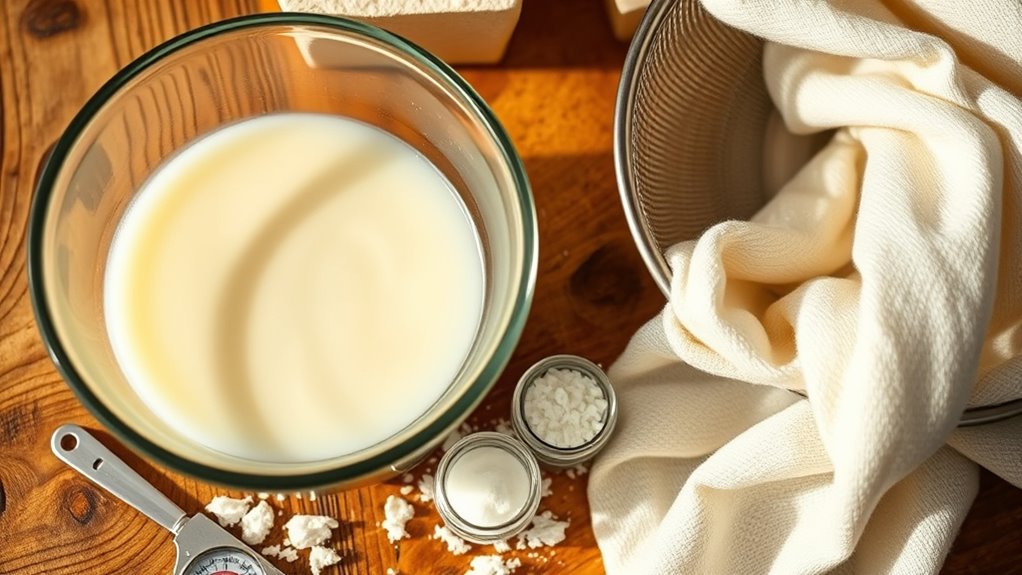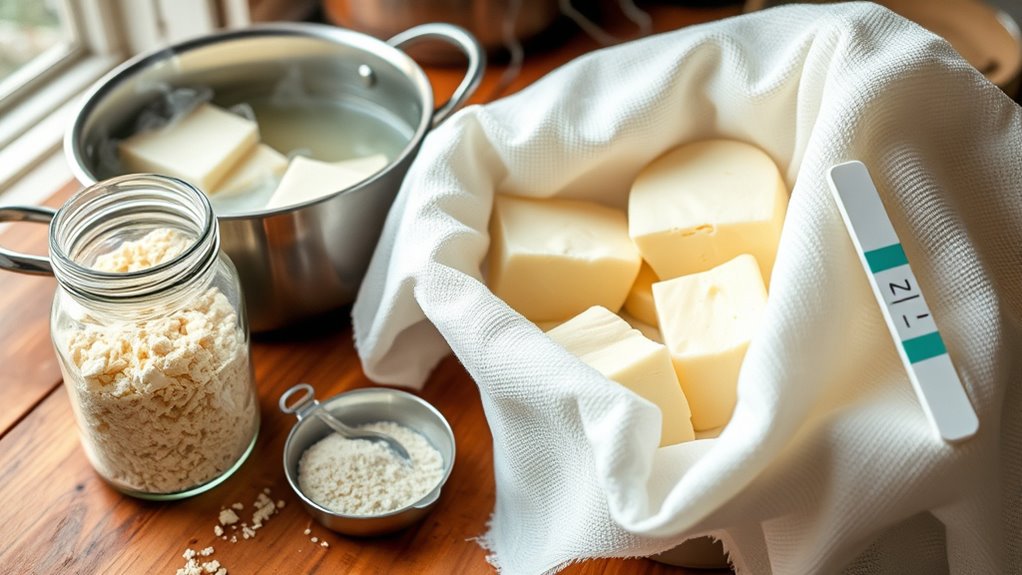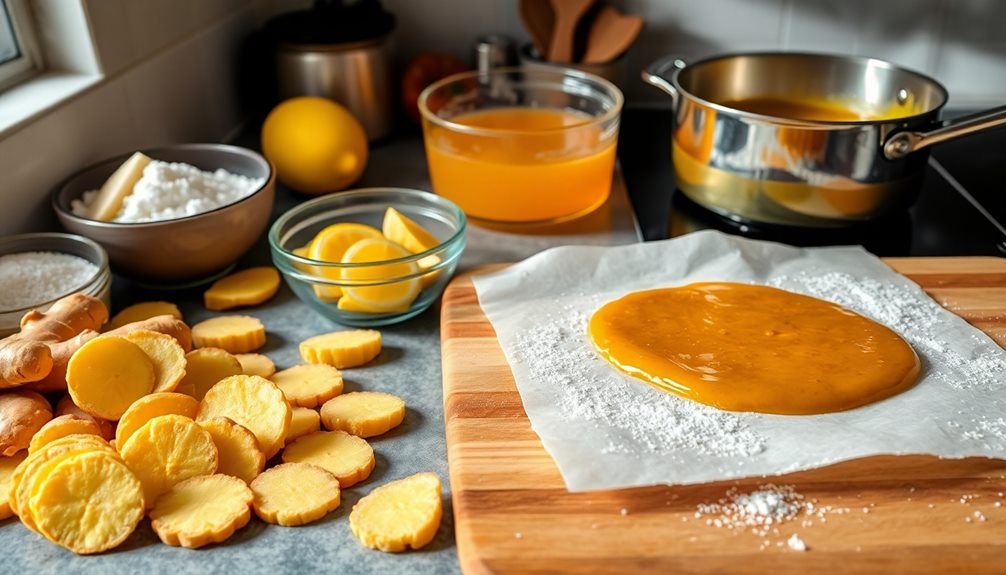To balance calcium and acid during homemade cheese making, monitor your milk’s pH and control acid addition carefully. As fermentation progresses, acid lowers pH, affecting calcium solubility and curd strength. Adding calcium chloride can help strengthen the curd if it becomes too soft, while controlling fermentation guarantees you don’t over-acidify. Mastering this balance will give your cheese the desired texture and flavor—continue exploring these techniques to perfect your cheese craft.
Key Takeaways
- Monitor milk pH regularly to ensure it stays within the ideal 5.2–5.4 range for optimal curd formation.
- Adjust calcium levels using calcium chloride to strengthen curds if acidification causes them to weaken.
- Control fermentation speed to manage acid production, preventing overly rapid pH drops that can affect cheese texture.
- Add acid gradually during cheese making to maintain balance between acidity and calcium solubility.
- Use precise measurements and consistent testing to achieve a harmonious balance of calcium and acid for desired cheese quality.

When making cheese at home, understanding how to balance calcium and acidity is key to achieving the right texture and flavor. The first step is to monitor your milk pH carefully. Milk pH indicates its acidity level and typically ranges from 6.5 to 6.7 before fermentation begins. As you add starter cultures or acidifying agents, you’ll notice the pH dropping, which helps the milk curdle and form the basis of your cheese. Keeping an eye on milk pH ensures you don’t let it become too acidic too quickly, which can cause a crumbly texture, or stay too alkaline, resulting in a softer, less cohesive cheese.
Monitoring milk pH is essential for achieving the perfect cheese texture and flavor.
Calcium levels play a pivotal role in how your cheese turns out. Calcium acts as a protein network binder, holding the protein network together during coagulation. If calcium levels are too high, the curd becomes firm and dense, which is desirable in cheeses like Parmesan. Conversely, low calcium can lead to weak curds that break apart easily, producing a crumbly cheese. To control calcium, you can add calcium chloride to pasteurized milk, especially if the milk has been stored for a while or is low in natural calcium. Proper calcium levels also influence how the cheese ages and develops flavor, so adjusting calcium carefully during the process makes a significant difference. Additionally, understanding calcium regulation can help you better control the cheese-making process for different cheese varieties.
Balancing milk pH and calcium involves a delicate interplay. As you add acid to lower the pH, calcium can become more soluble, weakening the curd structure if not managed properly. To counter this, some cheese makers add calcium chloride to boost calcium levels, strengthening the curd and maintaining a desirable texture. You also need to be mindful of how fermentation influences both factors. For example, certain bacteria produce lactic acid, which reduces pH gradually, allowing the calcium in the milk to form a solid gel. This slow acidification helps create a cheese with a smooth, cohesive texture. Understanding acidification techniques is essential for tailoring the process to specific cheese styles.
Ultimately, your goal is to reach the ideal pH range—usually around 5.2 to 5.4 for most cheeses—while maintaining appropriate calcium levels. This balance ensures your cheese isn’t too crumbly or too soft, and it develops the flavor and texture you’re aiming for. Regularly testing both milk pH and calcium levels during the process gives you better control, resulting in a consistent, high-quality cheese every time. Paying attention to these details may take practice, but mastering them is essential for successful cheese making at home. Maintaining awareness of these cheese-making principles can significantly improve your results and help you create cheese with a professional quality.
Frequently Asked Questions
How Does Water Mineral Content Affect Calcium and Acid Balance?
Water mineralization and composition directly impact calcium and acid balance in your cheese-making process. Hard water with high mineral content adds extra calcium, which can alter curd formation, while soft water might lack sufficient calcium. Additionally, minerals like magnesium and bicarbonates influence acidity. You should test your water’s mineralization levels and adjust accordingly, ensuring ideal water composition for consistent cheese quality and proper calcium-acid balance.
Can Natural Additives Replace Commercial Calcium or Acid Adjustments?
Imagine transforming your cheese with nature’s magic—can herbal additives or fermentation techniques replace commercial calcium or acid adjustments? You can, to some extent, by using herbs rich in calcium or fermentation methods that naturally develop acidity. These natural options can enhance flavor and texture without synthetic additives. However, they might not offer the precise control you need, so experiment carefully and understand that balance is key for perfect cheese.
What Are Common Mistakes That Throw off Calcium-Acid Balance?
When managing the calcium-acid balance, you often make mistakes like calcium mismeasurement or acid misapplication. These errors can throw off your cheese’s texture and flavor. For example, using inaccurate calcium measurements can cause insufficient curd formation, while improper acid application can lead to overly tangy or bland cheese. To avoid this, always measure ingredients carefully and follow your recipe’s acid instructions precisely, ensuring a balanced, quality cheese.
How Does Aging Influence Calcium and Acid Levels in Cheese?
Think of aging as a slow dance where calcium migration and acid development play leading roles. As cheese ages, calcium gradually moves, affecting texture and flavor, while acid levels deepen, enhancing complexity. I once watched a fresh cheese turn crumbly after months—its calcium had migrated, and acids intensified. Aging fine-tunes this balance, making your cheese richer and more flavorful over time.
Are There Specific Recipes Better Suited for Balancing Calcium and Acid?
You’ll find that calcium-rich recipes, like aged cheddar or Parmesan, naturally have higher calcium levels, while fresh cheeses like ricotta or mozzarella tend to be more acid-balanced. For better balancing, choose acid-balanced cheese types such as paneer or queso blanco, which are easier to make at home. Adjusting your recipe’s acidity and calcium content allows you to craft cheeses with the perfect texture and flavor.
Conclusion
By carefully balancing calcium and acid, you can create cheese with the perfect texture and flavor at home. For example, if you notice your cheese turning out too crumbly, adjusting the acid levels can help improve its smoothness. Remember, small tweaks make a big difference. With practice, you’ll develop a feel for your cheese’s needs, turning a simple hobby into a rewarding craft. Keep experimenting, and enjoy the delicious results of your effort.









